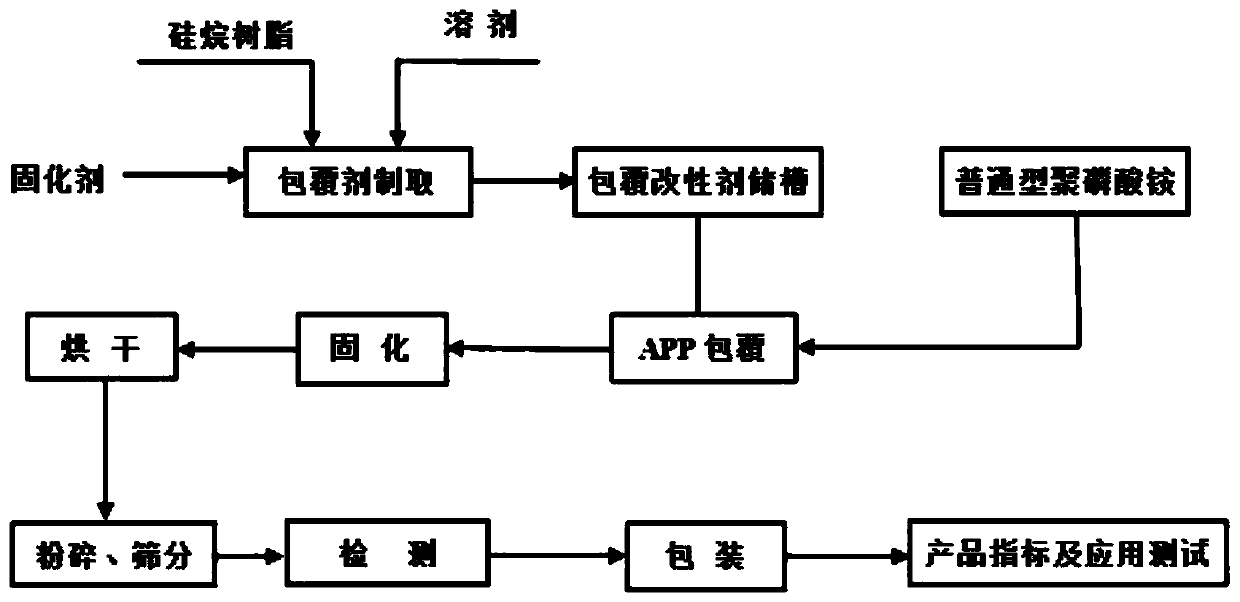Flame-retardant material for textiles and preparation method thereof
A technology for flame retardant materials and textiles, applied in the field of flame retardants, can solve problems such as poor compatibility and easy precipitation, and achieve the effects of enhanced reactivity, low solubility, and increased specific surface area
- Summary
- Abstract
- Description
- Claims
- Application Information
AI Technical Summary
Problems solved by technology
Method used
Image
Examples
Embodiment 1
[0027] a kind of like figure 1 The preparation method of the flame retardant material used for textiles is characterized in that, specifically, the steps are as follows:
[0028] (1) Preparation of siloxane resin coating agent:
[0029] Add 5 parts of solvent trimethylhydroxysilane and 3 parts of methanol into the reactor, and start stirring after the addition is complete. Then slowly add 7.5 parts of siloxane resin, namely dimethyldichlorosilane. Continue stirring, turn on the electric heater, slowly raise the temperature to 75°C, and keep stirring for 1.5 hours. Add 0.15 parts of curing agent 4,4-diaminophenylmethane into the reactor, stir for another 15 minutes, stop stirring, and turn off the electric heater. After the coating agent is prepared, it is reserved for use in the next process. Prepare the silicone resin coating agent through the above operating procedures;
[0030] (2) Coating modification of ammonium polyphosphate (APP):
[0031] Add 85 parts of general-...
Embodiment 2
[0036] a kind of like figure 1 The preparation method of the flame retardant material used for textiles is characterized in that, specifically, the steps are as follows:
[0037] (1) Preparation of siloxane resin coating agent:
[0038] Add 6.5 parts of solvent trimethylhydroxysilane and 3 parts of ethanol into the reactor, and start stirring after the addition. Then slowly add 7 parts of siloxane resin, namely vinyl triethoxysilane. Continue to stir, turn on the electric heater, slowly raise the temperature to 73°C, and keep stirring for 2.0 hours. Add 0.2 parts of curing agent triethylenetetramine into the reactor, stir for another 16 minutes, stop stirring, and turn off the electric heater. After the coating agent is prepared, it is reserved for use in the next process. The silane resin coating agent is prepared through the above operating procedure.
[0039] (2) Coating modification of ammonium polyphosphate (APP):
[0040] Add 88 parts of general-type ammonium polyp...
Embodiment 3
[0045] a kind of likefigure 1 The preparation method of the flame retardant material used for textiles is characterized in that, specifically, the steps are as follows:
[0046] (1) Preparation of siloxane resin coating agent:
[0047] Add 8 parts of solvent trimethylhydroxysilane and 3 parts of methanol into the reactor, and start stirring after the addition is complete. Then slowly add 3 parts of aminosilane resin and 5 parts of methacryloxysilane resin. Continue to stir, turn on the electric heater, slowly raise the temperature to 79°C, and keep stirring for 4.5 hours. Add 0.1 part of curing agent 4,4-diaminophenylmethane and 0.2 part of triethylamine into the reactor, stir for another 20 minutes, stop stirring, and turn off the electric heater. After the coating agent is prepared, it is reserved for use in the next process. The siloxane resin encapsulating agent was prepared through the above operating procedures.
[0048] (2) Coating modification of ammonium polyphosp...
PUM
| Property | Measurement | Unit |
|---|---|---|
| degree of polymerization | aaaaa | aaaaa |
Abstract
Description
Claims
Application Information
 Login to View More
Login to View More - R&D
- Intellectual Property
- Life Sciences
- Materials
- Tech Scout
- Unparalleled Data Quality
- Higher Quality Content
- 60% Fewer Hallucinations
Browse by: Latest US Patents, China's latest patents, Technical Efficacy Thesaurus, Application Domain, Technology Topic, Popular Technical Reports.
© 2025 PatSnap. All rights reserved.Legal|Privacy policy|Modern Slavery Act Transparency Statement|Sitemap|About US| Contact US: help@patsnap.com


